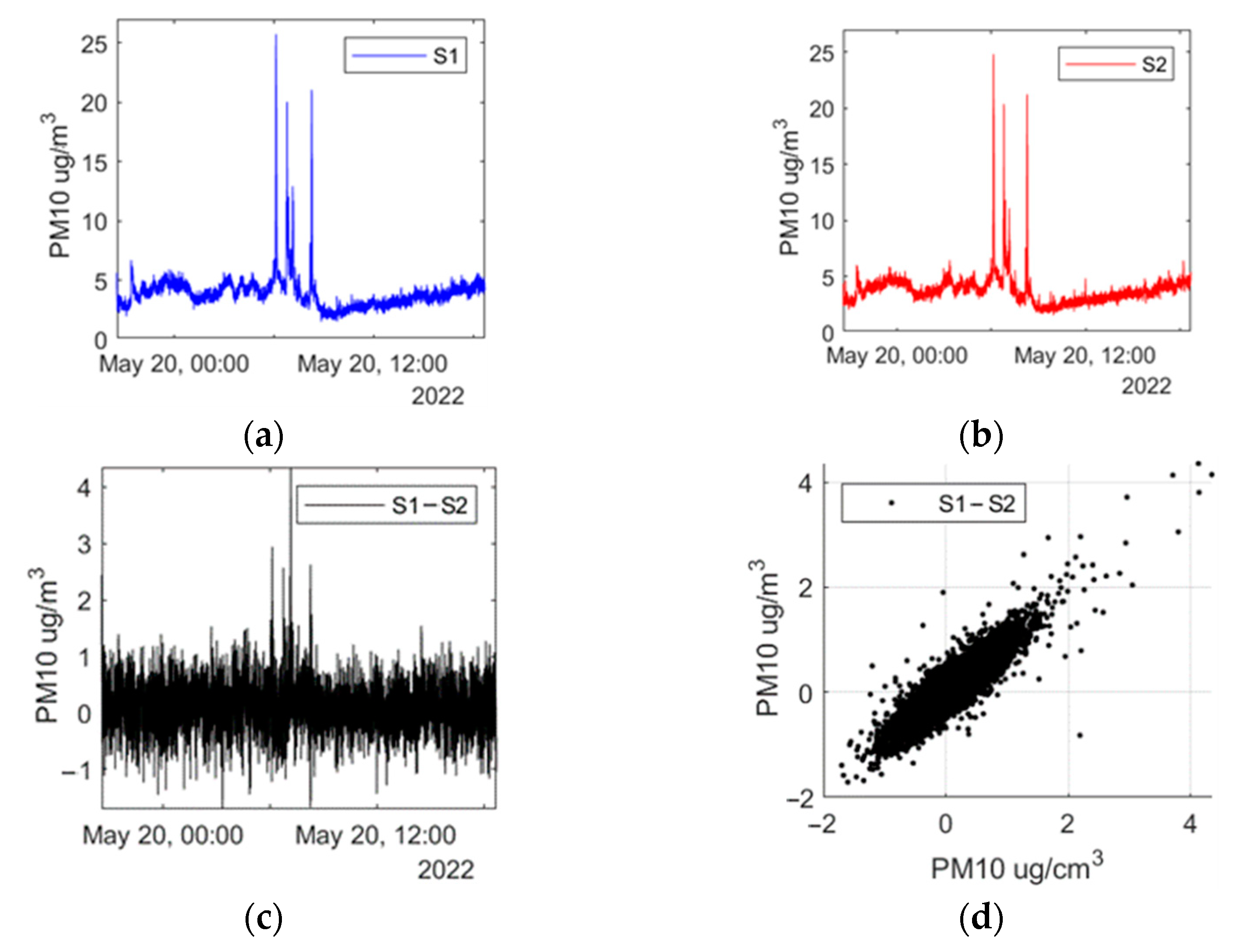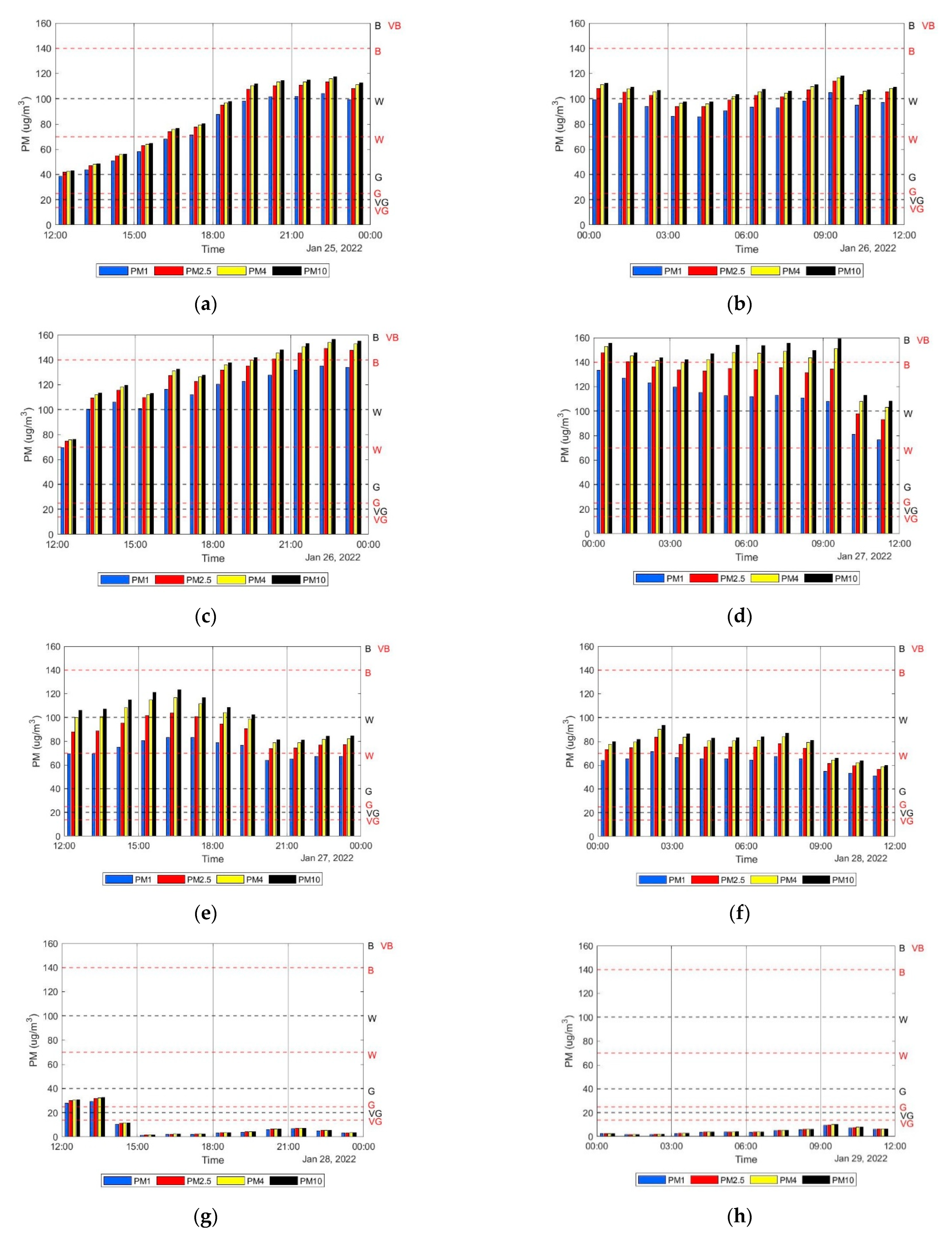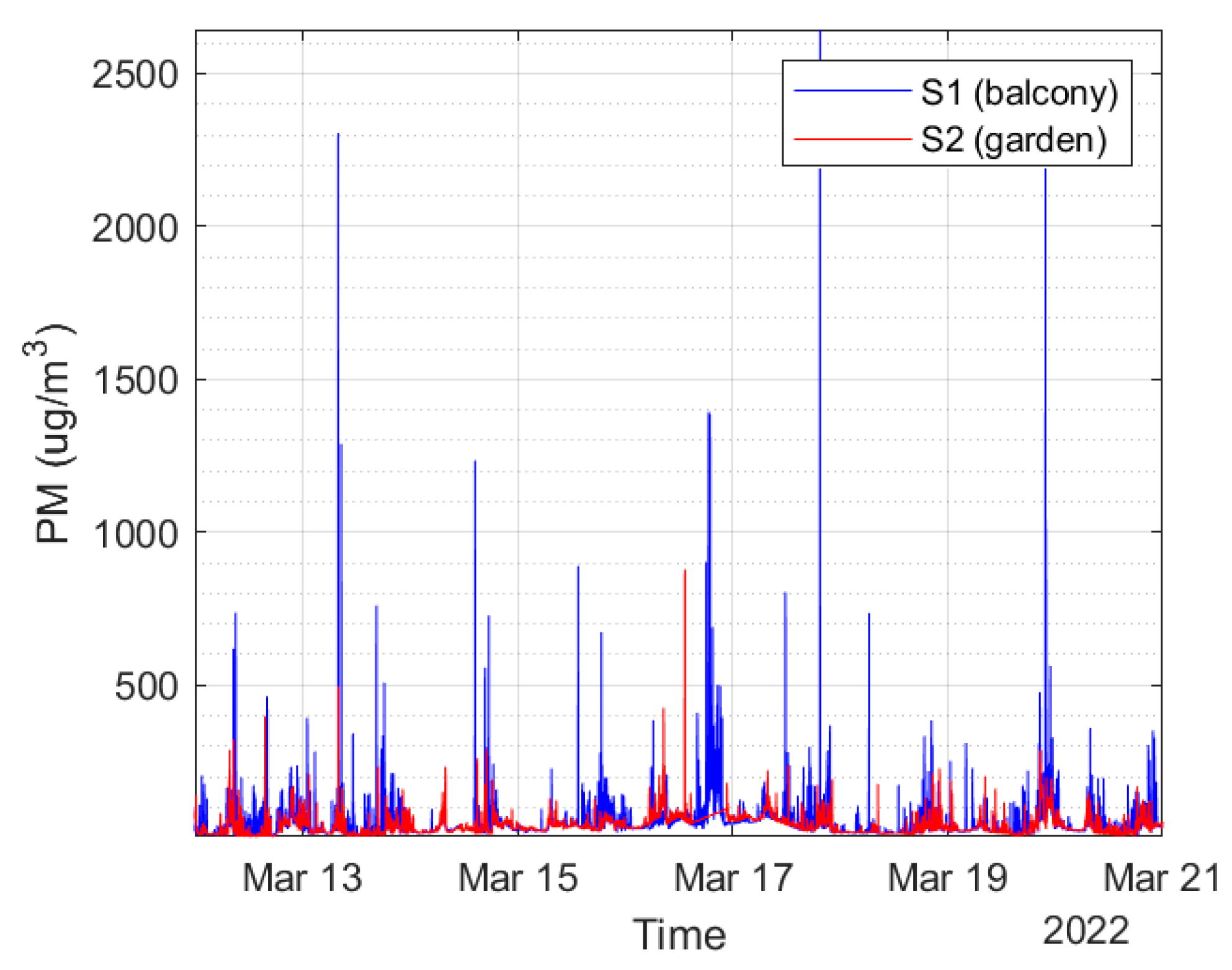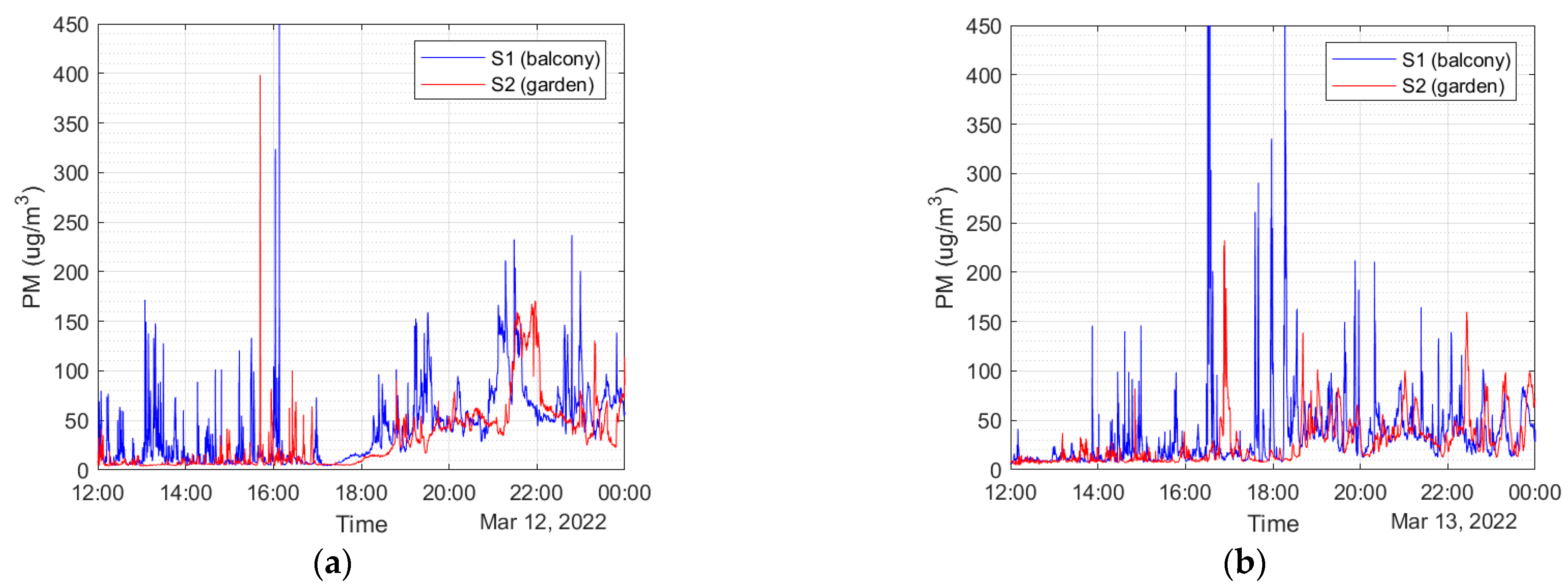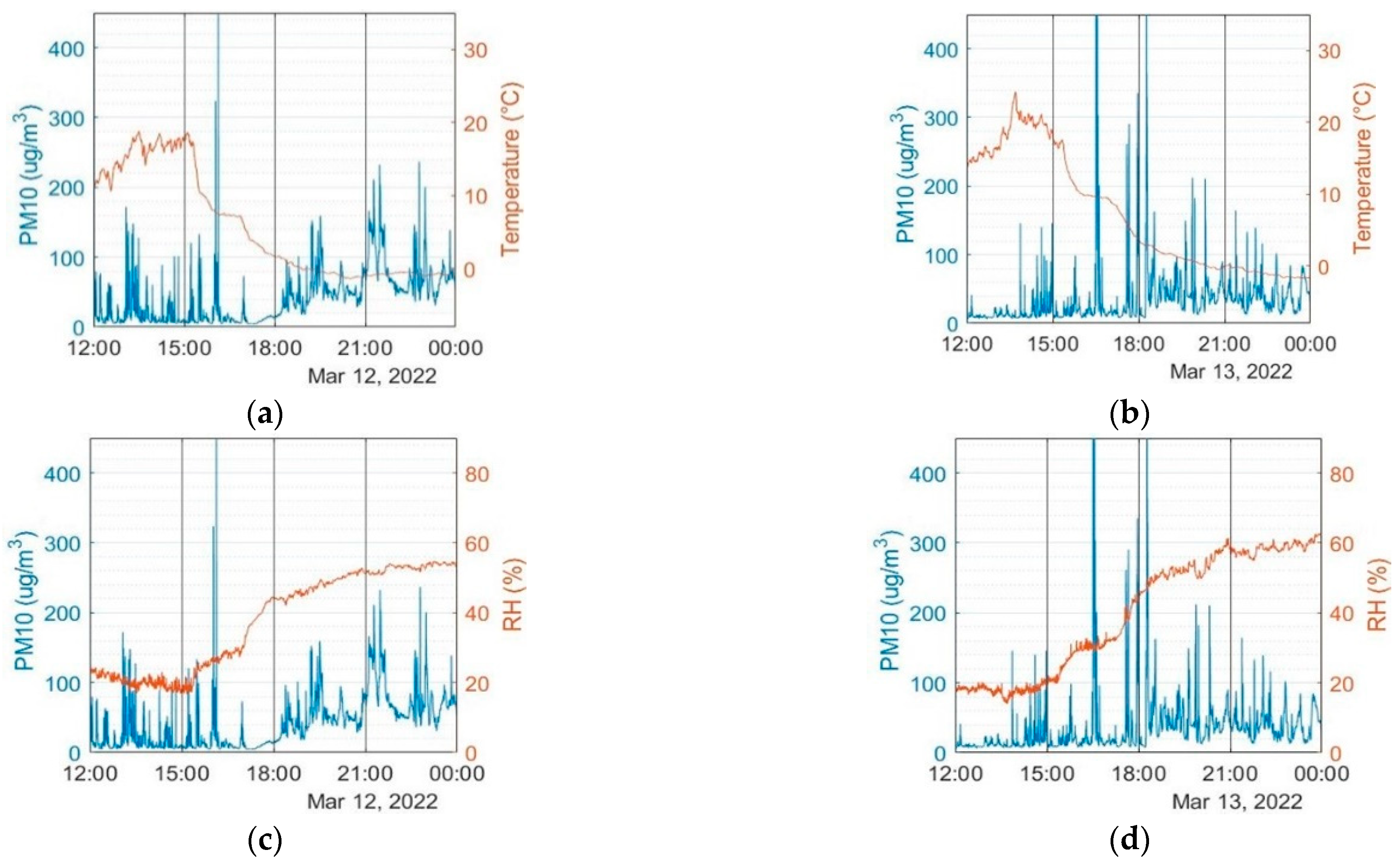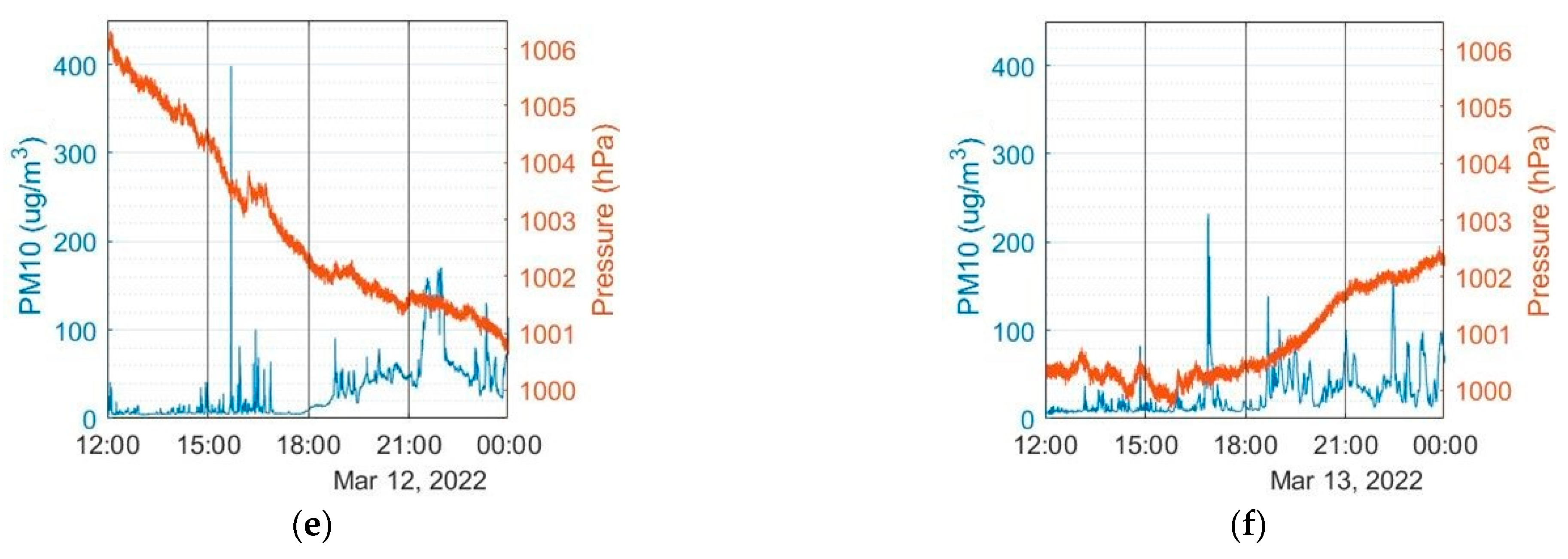3.1. Measurements in Košice, Slovakia
During the first set of measurements (in Košice, Slovakia, at the Department of Theoretical and Industrial Electrical Engineering, data available in
Table S3, Supplementary Materials) it was found that the air quality with respect to mass concentration of PM is usually (other than in a few exceptions) very good (VG) or good (G), as per
Table 4 [
26].
Good air quality was also confirmed by the measurements conducted in January 2022 up until 25 January, when during the afternoon hours (
Figure 3a), the mass concentration of PM started to steadily increase. The hourly average of PM10 mass concentration increased from ~40 µg/m
3 at 12:00 to 110 µg/m
3 at 19:00. The mass concentration stays roughly the same for the next 12 h (
Figure 3b). It momentarily dips to ~80 µg/m
3 at 12:00 on 26 January 2022 (
Figure 3c), before it rises to ~160 µg/m
3 by 22:00. PM10 mass concentration then reaches 140–160 µg/m
3 for the next 11 h (
Figure 3d). However, it is important to note that mass concentration of PM1 starts falling during this period of time. The increase in PM10 compared to PM1 at 9:00 to 10:00 (
Figure 3d) is almost 50%, which only happens sometimes (during these measurements and also on 27 January at 15:00 to 18:00—
Figure 3e). From 27 January 2022 at 22:00, the concentration of particulate matter (all measured categories) starts decreasing (
Figure 3d–g), until it reaches the hourly average of 1 µg/m
3 on 28 January 2022 at 15:00, after which the mass concentration stays in the category of very good (VG) air quality levels. The decrease in mass concentration at 11:00–15:00 (
Figure 3f,g) is significant. The levels of mass concentration of particulate matter as measured on 25 to 28 January 2022 12:00 (
Figure 3a–f) are not typical for this location. Measurements carried out on 28 January 2022 12:00 and onwards (
Figure 3g,h) are much closer to the mass concentration, which is usually measured at the Department of Theoretical and Industrial Electrical Engineering (DTIEE), FEEI, TU of Košice.
AQI was calculated from the daily averages of PM2.5 and PM10 for the better understanding of air quality.
Table 1 contains the AQI categories characterized by the levels of concentration of different air pollutants (PM2.5, PM10, CO, O
3, SO
2 and NO
2) [
23,
24]. AQI sub-indices for each pollutant are calculated using Equation (1). The resulting AQI is equal to the maximum value of the AQI sub-indices. Since only PM was measured and no other air pollutants, the overall AQI cannot be determined. However, the I
PM2.5 and I
PM10 can be calculated, and they do carry an informative value of how PM impacts air quality and which PM has greater impact.
Table 5 consists of daily averages of PM2.5 and PM10 and their respective AQI sub-indices. For three days (25 to 27 January 2022), the air quality is unhealthy. On 28 January 2022 the air quality is unhealthy for sensitive groups. However, on 29 January 2022 the air quality finally reaches good levels. In all cases, I
PM2.5 negatively influenced the air quality to a greater degree than I
PM10, which is also the case in the following measurements in March 2022 (
Section 3.2). Nevertheless it should be noted that this long term increase (lasting about four days) in PM mass concentration is rare in Košice at DTIEE, as we have found that the PM mass concentration measured on 29 January 2022 is much more true to the usual levels (as has been found in our previous measurements in [
22]).
The measurements were divided into 12-h (for which the hourly averages of PM mass concentration were calculated and visualized in
Figure 3), 6-h and 3-h long intervals. For each interval correlation coefficients between all possible pairs of measured quantities were calculated. In the following tables we present
r between PM10 and temperature, humidity, and pressure. Correlation coefficients during the 12-h intervals are shown in
Table 6; 6-h intervals in
Table 7; and 3-h intervals in
Table 8. The cells in
Table 6,
Table 7 and
Table 8 with corresponding correlation coefficient (
r) are shaded in three colors. White color indicates weak correlation (|
r| < 0.4) (or no correlation, when
r approaches 0); light grey indicates moderate correlation (0.4 < |
r| < 0.8) and dark grey indicates strong correlation (|
r| > 0.8) [
27]. The asterisk marks
r close to the lower limit of moderate or strong correlation.
As can be seen from
Table 6, there are only four measurements with weak correlation and one with none. The rest of the measurements show correlation; most of them moderate but some show strong correlation (ex. |
r| = 0.93–0.94, a very close relationship between the measured quantities). The first row (25 January, 12:00–24:00) indicates strong correlation between PM10 and Temperature, and Humidity; and moderate correlation between PM10 and pressure. In the 2nd row, there is a weak correlation on 26 January, 0:00–12:00. Furthermore,
r for PM10 and Pressure equals −0.003 (no correlation).
After performing a post-hoc test to get the adjusted
p-values (two-tailed,
n = 8640), it was found that all except for one
p-value were less than α (as corresponding to
Table 3).
After dividing the 12-h interval ex. of the second row from
Table 6 (26 January, 0:00–12:00) into 6-h intervals (
Table 7), it is apparent that out of six correlation coefficients, three show moderate correlation (between PM10 and Pressure, during the 0:00–6:00 and 6:00–12:00 intervals and between PM10 and Temperature during the 0:00–6:00 interval). This finding is interesting, since
r between PM10 and Pressure was close to zero during the 12-h interval, while the 6-h intervals both show moderate correlation.
All
p-values (two-tailed,
n = 4320) except for one in
Table 7 were equal to or lesser than α (as corresponding to
Table 3).
Even more interesting is the case when the same 12-h interval from
Table 6 is divided into four 3-h intervals, which means 12 correlation coefficients will be calculated.
Table 8 shows that out of all 3-h intervals, only three of them show weak or no correlation for all the physical quantities (white cells of the table) and the rest of the interval shows mostly moderate correlation. Another surprise in
Table 7 and
Table 8 is that for the first row in
Table 6 (25th January, 12:00–24:00),
r for PM10 and Pressure during the 12-h interval is −0.703, while for the 6-h intervals
r = −0.681 and −0.443. The biggest surprise was dividing the 12-h interval into 3-h intervals, as in
Table 8, for 25th January, 12:00–15:00
r = −0.815 and the other three intervals show no correlation (
r ≈ 0). It is possible to observe the development of
r for other measurements in
Table 8 in a similar way.
All except for seven
p-values (two-tailed,
n = 2160) were equal to or lesser than α (as corresponding to
Table 3).
We were interested in finding what the changes were in measured quantities that correspond to
r calculated for the intervals in
Table 6,
Table 7 and
Table 8.
Figure 4 illustrates the changes in measured quantities over 12 h for the first and second row in
Table 6. Since the positive and negative correlations are indicated in the tables, it will be possible to observe the increase or decrease in both measured quantities in the case of positive
r, or the increase in one and the decrease in the other measured quantity in the case of negative
r. The timeline in
Figure 4 is divided into 3-h intervals, which means it will be possible to observe the change in measured quantities and
r corresponding not only for the 12-h intervals, but also for the 6-h and 3-h intervals.
The numbers written on the bottom of the graphs inside the 3-h intervals are the corresponding correlation coefficients from
Table 8 for the 3-h intervals. The numbers written in the middle of the graph next to the 6-h line are the corresponding
r from
Table 7 for the 6-h intervals and the number written in the top left corner of the picture is the corresponding
r from
Table 6 for the 12-h interval. In the left column, all the graphs show the measured quantities on 25th January, 12:00–24:00 and in the right columns, the graphs show the measured quantities on 26th January 0:00–12:00. The first row shows the changes in mass concentration of PM10 and Temperature, and the second row shows the changes in mass concentration of PM10 and Humidity. Finally, the 3rd row shows the changes in mass concentration of PM10 and Pressure.
In
Figure 4a it is apparent why
r = −0.931. The increase in PM10 mass concentration corresponds to the decrease in temperature, which is why
r is of such high value with a negative sign. Similarly, in
Figure 4c, the increase in PM10 mass concentration corresponds to the increase in Humidity, so
r = 0.941 with a positive sign.
Figure 4e is an answer to why
r = −0.703 for correlation between PM10 and Pressure. The barometric pressure is almost constant from 14:00 to 19:00 and it is the reason
r is not close to the value of −0.9, even though for the 3-h interval from 12:00 to 15:00,
r = −0.815. On the other hand, in
Figure 4f
r = −0.003 for the 12-h interval. However, for the 3-h or 6-h intervals
r shows moderate correlation between PM10 and pressure. Other graphs in
Figure 4 can be described in a similar way.
The question which arose from these measurements is: why is there not always at least moderate correlation between PM10 and other quantities? Why does the value of
r change significantly with each interval? If there was a relationship found between the mass concentration of particulate matter and other quantities, it would be possible to predict the future development of mass concentration of PM and therefore warn the population against the high concentration of PM in the air. Mass concentration of PM could be forecast similarly to weather. The air pollution by particulate matter changes not only with temperature, humidity, and pressure, but also with wind speed and direction [
12,
13]. Unfortunately, comparing the measured data with the wind speed and direction data has not yet been implemented in our measuring station due to a lack of availability of components or long delivery times needed for extending our measuring station with an anemometer.
3.2. Measurements in a Small Village
Another question is whether the place of measurement also affects the mass concentration of PM, and if so, to what degree. Therefore, a second set of measurements (
Figure 5) was carried out in a small village (the place of measurement described in 2.3. Measurement Locations). Measured data are available in
Tables S4–S6, Supplementary Materials.
As it can be seen in
Figure 5, values measured by sensor S1 on the balcony and sensor S2 in the garden differ. The most noticeable differences are during short-term peaks in mass concentration of PM10. For a better view,
Figure 6 shows a close-up on the 12:00–24:00 intervals on 12th (
Figure 6a) and 13th March (
Figure 6b). It is important to note, that while the y-axis scale is set to 450 µg/m
3, there are three peaks in
Figure 6b that exceed this scale:
- 1.
at 16:30:38, PM10 mass concentration was 477.37 µg/m3;
- 2.
at 16:32:18, PM10 mass concentration was 760.45 µg/m3;
- 3.
at 18:36:16, PM10 mass concentration was 508.15 µg/m3.
All three peaks were recorded on the balcony. Overall, a higher number of these peaks were recorded on the balcony as opposed to the garden. Not only are they more common on the balcony but they also reach higher values. Occasionally, S2 located in the garden recorded higher peaks (ex. at 15:41:49 PM10 mass concentration in the garden was 398.45 µg/m
3 in
Figure 6a) but that was a rare occurrence. However, the baseline levels of PM10 mass concentration are comparable between both measuring places, which are also documented by
Figure 7.
Figure 7 shows the hourly averages of mass concentration of particulate matter.
Figure 7a,b were calculated from the measurements that were conducted on the balcony while
Figure 7c,d were calculated from the measurements carried out in the garden. If we compare measurements from 12th March, 12:00–24:00, both the measurement on the balcony (
Figure 7a) and in the garden (
Figure 7c) follow a similar trend. The hourly averages of PM mass concentration tend to be slightly higher for the balcony measurements compared to the garden measurements, especially at 13:00–14:00, 19:00–20:00, 22:00–24:00. It can be seen from
Figure 6a that during that time, there were frequent peaks recorded by the sensor S1, but also the baseline PM mass concentration was higher on the balcony than in the garden. As for the measurements from 13th March, 12:00–24:00, the hourly averages of mass concentration of PM also tend to be higher for the balcony measurements (
Figure 7b) than the garden measurements (
Figure 7c). The biggest difference is at 14:00–15:00, 16:00–19:00. During other measured days the hourly averages of mass concentration are generally higher on the balcony as well. However, there were also a few exceptions when the mass concentration of PM was higher in the garden.
The question which we were interested in next was: how much does the correlation between PM10 and meteorological factors (temperature, humidity, pressure) change with the change in location? The measurements taken showed that even though the two measuring places were distant from each other by 35 m, there was a significant difference between the immediate mass concentration of PM (e.g., short but high peaks in the mass concentration) (
Figure 5 and
Figure 6) and a slight difference in hourly averages of the mass concentration of PM (
Figure 7). This raises the question: how will that affect the correlation?
Table 9 shows daily averages of PM2.5 and PM10 as well as their respective air quality sub-indices for the measurement on the balcony. The air quality reached moderate levels during a total of 5 days (on 12–14, 18 and 21 March), unhealthy for sensitive groups during a total of 5 days (on 11, 15, 17, 19 and 20 March) and unhealthy levels for one day (on 16 March).
As for I
PM2.5 and I
PM10 (
Table 10) for the garden measurement, the air quality was moderate during a total of 6 days (on 11–14, 18 and 20 March), unhealthy for sensitive people during a total of 4 days (on 15, 17, 19 and 21 March) and unhealthy during 1 day (on 16th March). Hourly averages of PM2.5 and PM10 as well as I
PM2.5 and I
PM10 were better in the garden (
Table 10) than on the balcony (
Table 9) every day except for 21 March 2022. This is another confirmation that the distance from the source of PM (family houses which use wood combustion as a heat source) impacts the air quality.
Next, both measurements were divided into 12-h intervals.
Table 11 and
Table 12 consist of the correlation coefficients from the measurement on the balcony and in the garden, respectively. As is the case with
Table 5,
Table 6 and
Table 7, the cells within the table are colored according to how strong the correlation between PM10 and other physical quantities is. If |
r| < 0.4, then the cells are white, as there is weak correlation (or no correlation if
r approaches 0). If 0.4 < |
r| < 0.8, there is moderate correlation, and the cells are shaded light grey. Dark grey is used for cells with |
r| > 0.8, or strong correlation [
27]. However, in our case, no strong correlation was found in
Table 11 and
Table 12, so there are no cells shaded with dark grey color. For most intervals, in both
Table 11 and
Table 12, either weak or no correlation was found. In
Table 11, only 15 out of 54 correlation coefficients show moderate correlation. In
Table 12, the number of correlation coefficients that correspond to moderate correlation is 21. Seven cells in total change from having none or weak correlation in
Table 6 to having moderate correlation in
Table 7 and one cell changes from
r > 0.4 in
Table 11 to
r < 0.4 in
Table 12 (correlation between mass concentration of PM10 and temperature on 15 March, 0:00–12:00). However, the value of this cell in
Table 12 is 0.384, which is close to 0.4. Still in most cases, the correlation improves during the garden measurement (
Table 12). There is even one interval, in which all correlations (between PM10 and temperature, PM10 and humidity, as well as PM10 and pressure) improve from weak correlation in
Table 11 to strong correlation in
Table 12—13 March, 12:00–24:00. Mass concentration of PM10 during this interval can be seen in
Figure 6b (both the balcony and the garden measurement) and the hourly averages of mass concentration of PM is shown in
Figure 7b (the balcony measurement) and
Figure 7d (the garden measurement). The cells, which have moderate correlation in
Table 11 and weak correlation in
Table 12 and vice versa, are marked by one asterisk (*).
Although there are many cases where correlation coefficient changes from
Table 11 to
Table 12, there are also some intervals, in which the changes are very small. Cells, in which the difference between
r in
Table 11 and
Table 12 is smaller than 0.05, are marked with a double asterisk (**). There are eight such cells, three of which belong to the same interval (12 March, 12:00–24:00). The mass concentration of PM10 for this interval is shown in
Figure 6a and the hourly averages in
Figure 7a,c. The comparison of PM10 mass concentration and meteorological factors for those intervals is shown in
Figure 8 and
Figure 9.
The fact that most correlation coefficients indicate either weak or no correlation, and some indicate only moderate correlation (
Table 11 and
Table 12), while the previous measurements in Košice showed the majority of intervals as having moderate correlation with some strong correlation or weak correlation, may be caused by the peaks that have been measured in the village. After all, even the garden measurements, which show smaller peaks that are less frequent, improve the correlation slightly. In Košice no peaks were measured and therefore mass concentration of PM is distributed more evenly even during a longer time interval. This even distribution is disrupted in the village by residents in family houses burning wood and therefore creating these local non-regular short increases in particulate matter. These peaks then affect the correlation found in
Table 6 and
Table 7.
As for the
p-values corresponding to
r in
Table 11 and
Table 12, there were eleven
p-values (two-tailed,
n = 8640) which exceeded α (as corresponding to
Table 3) in
Table 11, and only five
p-values which exceeded α in
Table 12. For the rest of the intervals,
p ≤ α. This suggests that the peaks, which are more often found in the balcony measurement (
Table 11), negatively impact the correlation between PM and meteorological factors.
To better illustrate correlation, the changes in PM10 mass concentration and temperature, humidity, and pressure during the intervals mentioned above (12 and 13 March, 12:00–24:00) are shown in
Figure 8 (balcony measurement) and
Figure 9 (garden measurement). In
Figure 8b,d,f, three peaks of PM10 mass concentration exceed the y-axis scale, just like in
Figure 6b. They reach 477.37, 760.45 and 508.15 µg/m
3. The effect the peaks have on the correlation can be best seen in
Figure 8b, where PM10 mass concentration and temperature are plotted. Even in the section where temperature is constant or decreasing slowly (18:00–24:00), there is still a number of changes in PM10 caused by the peaks. Therefore, it is reasonable that weak correlation was found in those intervals.
Now compare the changes in PM10 mass concentration in
Figure 8b to the changes in PM10 mass concentration in
Figure 9b. The peaks are smaller, but, more importantly, less frequent, and therefore the distribution of mass concentration is more uniform. There are still some peaks, and there are not many clear examples when both quantities simultaneously increase or decrease, or where one quantity increases and the other quantity decreases (compared to
Figure 4, when such intervals can be clearly identified). As such, from the graph in
Figure 9b, it is more difficult to predict whether there will be any correlation found. However, we can rely on the correlation coefficient to reveal if there is any correlation between the measured quantities and how strong it is (ex., for
Figure 9b). Moderate correlation was found between PM10 mass concentration and temperature. Other graphs in
Figure 8 and
Figure 9 can be compared in a similar way.
